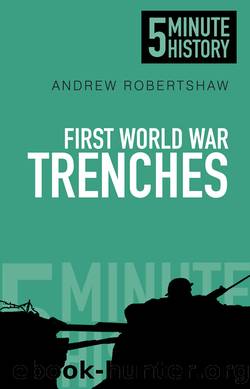First World War Trenches by Andrew Robertshaw

Author:Andrew Robertshaw
Language: eng
Format: epub
ISBN: 9780750955140
Publisher: The History Press
Published: 2014-02-13T00:00:00+00:00
Corporal George Coppard, Machine Gun Corps11
From the outbreak of war, machine guns were an ideal weapon in trench warfare, but the water-cooled British Vickers or German Maxim were heavy and difficult to conceal. They also could not be easily carried forward into the attack or positioned to protect a vulnerable position in the front line. The result of this was that the British Army purchased examples of the Lewis automatic rifle, which was air cooled and relatively light, from the US company. By late 1915, the Lewis gun had entirely replaced the Vickers in the front line and these weapons were transferred to the new specialist Machine Gun Corps (MGC), which could use the long range of this weapon in force more effectively. The German response was to convert some of their Maxim machine guns to light weapons, although these retained the water jacket and were far heavier than the Lewis. Both French forces and the Americans used the French Chauchat as a light weapon, and the American-manufactured Browning automatic rifle entered service in 1918.
Raiding called for specialist weapons, as rifles with bayonets were long and cumbersome, and grenades noisy. If a silent attack was required, soldiers used trench clubs, which were like medieval maces, often made in workshops behind the lines. German troops favoured a standard entrenching tool with a sharpened blade, and these were reputed to be able to cut through a British helmet and the wearerâs head. Some troops made use of pistols in raiding and men made some attacks with a pistol in each hand like a Western gun fighter. The actual combination of weapons and levels of concealment depended upon the nature of the raid and level of experience of the troops. The Germans had specialist raiding units, referred to by the British as the âBosch Flying Circusâ. These expert raiders were able to use speed and stealth to capture prisoners, examples of new weapons and intelligence information. Cloudy, moonless nights kept all soldiers âon their toesâ and a poor sentry who failed to spot a raider wearing dark clothing had often made his last mistake. Both sides patrolled no-manâs-land at night, even if there were no raids planned. Dominating this area was regarded as being vital to prevent men from becoming defensive and lacking in offensive spirit. Clashes in the dark were frequent, as the patrols clashed in the long grass and weeds between the lines and men were killed or wounded as they cut down this growth to clear âfields of fireâ and prevent the enemy using it as cover.
Download
This site does not store any files on its server. We only index and link to content provided by other sites. Please contact the content providers to delete copyright contents if any and email us, we'll remove relevant links or contents immediately.
| Atlases & Gazetteers | Historical |
| Travel Maps | United States |
| World |
Goodbye Paradise(3761)
Atlas Obscura by Joshua Foer(2931)
Tokyo by Rob Goss(2405)
Borders by unknow(2280)
Lonely Planet New York City by Lonely Planet(2194)
DK Eyewitness Top 10 Travel Guides Orlando by DK(2150)
Top 10 Dubai and Abu Dhabi by DK Travel(2074)
Tomb of the Panzerwaffe: The Defeat of the Sixth SS Panzer Army in Hungary 1945 by Aleksei Isaev & Maksim Kolomiets(1845)
Rick Steves London 2018 by Rick Steves & Gene Openshaw(1842)
Dirt by Bill Buford(1649)
The Path Between the Seas by David McCullough(1583)
the fault in our stars by john green(1523)
Atlas of Improbable Places by Travis Elborough(1513)
The Travels by Marco Polo(1478)
Tokyo on Foot by Florent Chavouet(1476)
The Lives of Conn Smythe by Kelly McParland(1456)
Need by Unknown(1440)
The Lord of the Rings: The Fellowship of the Ring, the Two Towers, the Return of the King by J. R. R. Tolkien(1408)
Still Alice by Lisa Genova(1400)
